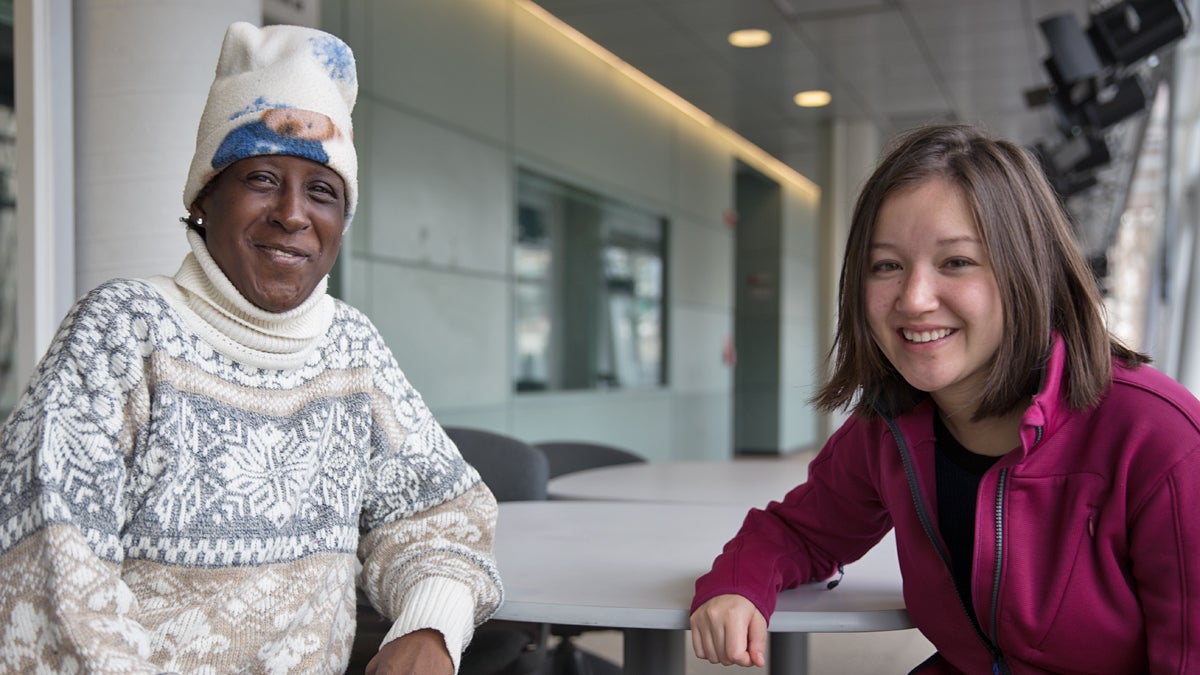A lesson in the ‘patient experience:’ Program requires med students to follow patients over time
Listen
Linda Hines-Gordon (left) and Amelia Breyre recently completed Penn's LEAPP program
A medical student learns about chronic health issues through the lens of a patient in an 18-month intensive course requirement at the University of Pennsylvania.
Medical school, especially that first year, is packed with anatomy, physiology, exams, exams and more exams. But last June, first-year Amelia Breyre, now 28, peeled away from her textbooks and precious study time, trekked over an hour through a public transit maze, to meet with Linda Hines-Gordon, 50, at her home on the outskirts of Philadelphia.
They chatted about health and family. Hines-Gordon showed Breyre wedding photos.
“You don’t see yourself as sick, do you?” Breyre later asks Gordon-Hines.
“No,” Gordon-Hines chimes back. “No, I don’t.”
Educators at the University of Pennsylvania consider this experience an essential part of Breyre’s medical schooling and development as a future doctor.
For more than ten years, the school has required that all students follow a patient living with a chronic disease for 18 months. Working in pairs, students must check in regularly, in person or by phone, even write essays.
Breyre recalls the first time she met Hines-Gordon.
“We didn’t meet you in the patient room, we met you in the waiting room,” she says.
“We got to talking,” recalls Hines-Gordon. “I told you how my day went, how my day goes.”
The hope of LEAPP, or Longitudinal Experience to Appreciate Patient Perspectives, is for students to learn early on that each person comes into that exam room with an experience and a story, according to Dr. Horace DeLisser, a critical care specialist and associate dean for diversity and inclusion at Penn’s Perelman School of Medicine.
“And if I can understand that, that enables me to do a better job for a patient, provide care that’s meaningful on their terms,” says DeLisser. “If you get in that habit of trying to understand a patient’s story, what’s going through their experience, that helps inform and guide how to engage the patient.”
DeLisser thinks introducing these concepts to medical students on day one can help combat cynicism and burnout later on. It also ensures they see good patient-doctor interactions and relationships.
Plus, he adds, getting to know people is fun.
Hines-Gordon was born with a congenital heart defect. She has diabetes and some other health issues. For Breyre, the biggest breakthrough involved that home visit. She recalls the tricky steps getting up to Hines-Gordon’s house, and the strong smell of smoke on her enclosed porch.
“Linda doesn’t smoke,” says Breyre. “But turns out her husband does. That’s something I wouldn’t have known about her otherwise.”
Select doctors recruit about 90 patients each year for LEAPP. They have a range of health issues and backgrounds. DeLisser says it’s not too hard to find willing participants, as many are eager to share their experiences, even help shape future doctors.
At least a dozen schools nationwide have some sort of pre-clinical longitudinal coursework in their curriculum, and it appears to be gaining in popularity. Similarly, students at Penn State must follow a patient for seven to eight months, with some even creating mini documentaries about their experience.
Breyre recently completed the 18 month program, with her schedule now bogged down with long hours on the surgical wing, in rotations. She’s still digesting the experience, and trying to make sense of what she learned. She wonders about what the patient-doctor relationship is supposed to be, how, as a doctor with limited time in an exam room, she’ll be able to garner the kind of important details she learned about Hines-Gordon, only after spending a lot of time with her and visiting her home.
“She’s rightly raising some important questions about how can the physician do it all. My response is you don’t need to do it all at once.” says DeLisser. “Rather than trying to get the entire story at once, each visit seek to learn something a little bit new.”
DeLisser says give it some time. It may take months, even years to realize the benefits.
On their most recent visit, Hines-Gordon tells Breyre she thinks she’ll be a good doctor. “I have confidence in you that you’ll good do a good job,” she tells Breyre. “And I hope to see you again!”
“That really means a lot to me,” Breyre responds. “I hope so to.”
WHYY is your source for fact-based, in-depth journalism and information. As a nonprofit organization, we rely on financial support from readers like you. Please give today.



